dashboard Lancia Musa 2010 Owner handbook (in English)
[x] Cancel search | Manufacturer: LANCIA, Model Year: 2010, Model line: Musa, Model: Lancia Musa 2010Pages: 218, PDF Size: 3.71 MB
Page 108 of 218
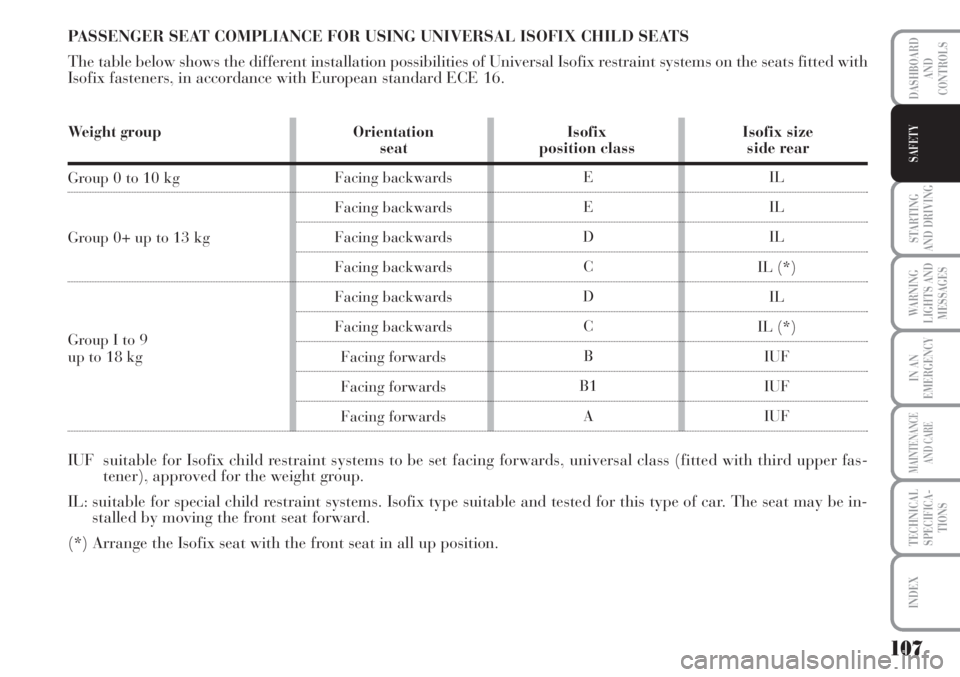
107
STARTING
AND DRIVING
WARNING
LIGHTS AND
MESSAGES
IN AN
EMERGENCY
MAINTENANCE
AND CARE
TECHNICAL
SPECIFICA-
TIONS
INDEX
DASHBOARD
AND
CONTROLS
SAFETY
PASSENGER SEAT COMPLIANCE FOR USING UNIVERSAL ISOFIX CHILD SEATS
The table below shows the different installation possibilities of Universal Isofix restraint systems on the seats fitted with
Isofix fasteners, in accordance with European standard ECE 16.
Weight group Orientation Isofix Isofix sizeseat position class side rear
Group 0 to 10 kg
Group 0+ up to 13 kg
Group I to 9
up to 18 kg
Facing backwards
Facing backwards
Facing backwards
Facing backwards
Facing backwards
Facing backwards
Facing forwards
Facing forwards
Facing forwardsE
E
D
C
D
C
B
B1
AIL
IL
IL
IL (*)
IL
IL (*)
IUF
IUF
IUF
IUF suitable for Isofix child restraint systems to be set facing forwards, universal class (fitted with third upper fas-
tener), approved for the weight group.
IL: suitable for special child restraint systems. Isofix type suitable and tested for this type of car. The seat may be in-
stalled by moving the front seat forward.
(*) Arrange the Isofix seat with the front seat in all up position.
Page 109 of 218
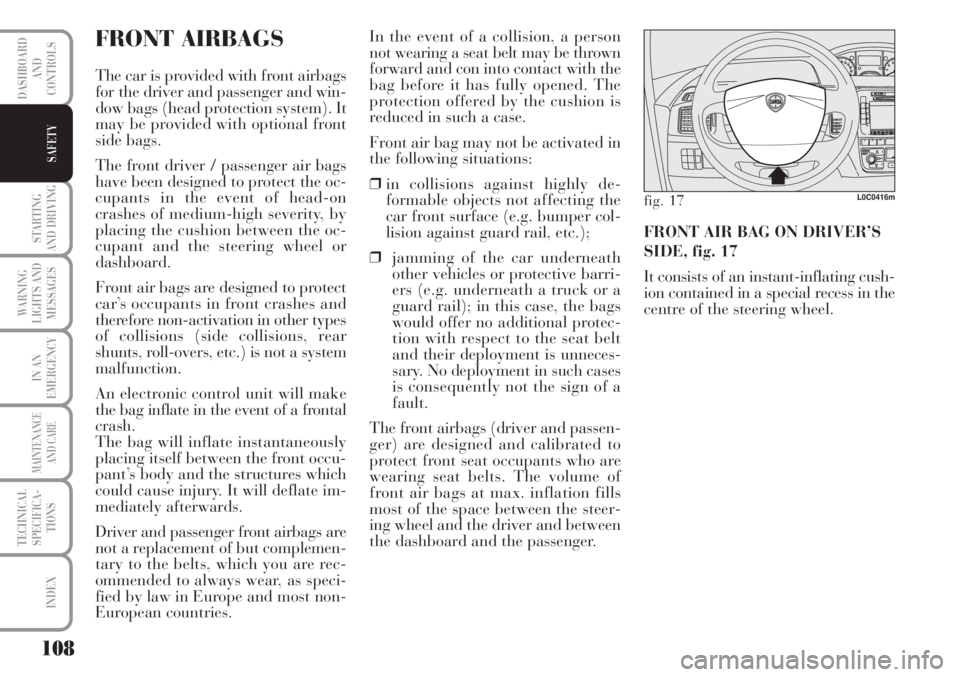
108
STARTING
AND DRIVING
WARNING
LIGHTS AND
MESSAGES
IN AN
EMERGENCY
MAINTENANCE
AND CARE
TECHNICAL
SPECIFICA-
TIONS
INDEX
DASHBOARD
AND
CONTROLS
SAFETY
FRONT AIRBAGS
The car is provided with front airbags
for the driver and passenger and win-
dow bags (head protection system). It
may be provided with optional front
side bags.
The front driver / passenger air bags
have been designed to protect the oc-
cupants in the event of head-on
crashes of medium-high severity, by
placing the cushion between the oc-
cupant and the steering wheel or
dashboard.
Front air bags are designed to protect
car’s occupants in front crashes and
therefore non-activation in other types
of collisions (side collisions, rear
shunts, roll-overs, etc.) is not a system
malfunction.
An electronic control unit will make
the bag inflate in the event of a frontal
crash.
The bag will inflate instantaneously
placing itself between the front occu-
pant’s body and the structures which
could cause injury. It will deflate im-
mediately afterwards.
Driver and passenger front airbags are
not a replacement of but complemen-
tary to the belts, which you are rec-
ommended to always wear, as speci-
fied by law in Europe and most non-
European countries.In the event of a collision, a person
not wearing a seat belt may be thrown
forward and con into contact with the
bag before it has fully opened. The
protection offered by the cushion is
reduced in such a case.
Front air bag may not be activated in
the following situations:
❒in collisions against highly de-
formable objects not affecting the
car front surface (e.g. bumper col-
lision against guard rail, etc.);
❒jamming of the car underneath
other vehicles or protective barri-
ers (e.g. underneath a truck or a
guard rail); in this case, the bags
would offer no additional protec-
tion with respect to the seat belt
and their deployment is unneces-
sary. No deployment in such cases
is consequently not the sign of a
fault.
The front airbags (driver and passen-
ger) are designed and calibrated to
protect front seat occupants who are
wearing seat belts. The volume of
front air bags at max. inflation fills
most of the space between the steer-
ing wheel and the driver and between
the dashboard and the passenger.FRONT AIR BAG ON DRIVER’S
SIDE, fig. 17
It consists of an instant-inflating cush-
ion contained in a special recess in the
centre of the steering wheel.
fig. 17L0C0416m
Page 110 of 218
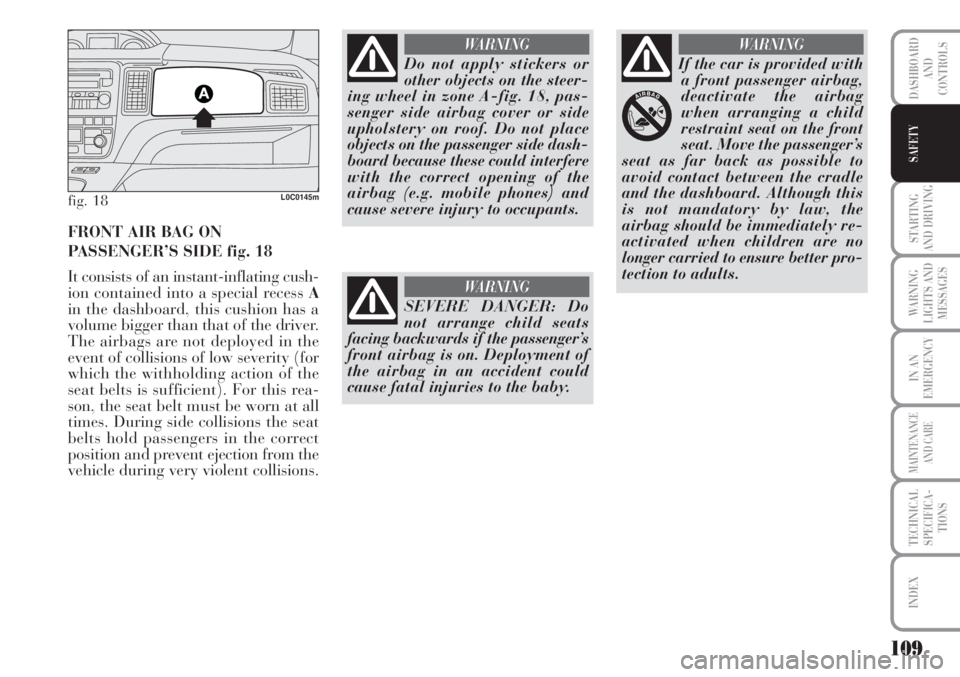
109
STARTING
AND DRIVING
WARNING
LIGHTS AND
MESSAGES
IN AN
EMERGENCY
MAINTENANCE
AND CARE
TECHNICAL
SPECIFICA-
TIONS
INDEX
DASHBOARD
AND
CONTROLS
SAFETY
fig. 18L0C0145m
FRONT AIR BAG ON
PASSENGER’S SIDE fig. 18
It consists of an instant-inflating cush-
ion contained into a special recess A
in the dashboard, this cushion has a
volume bigger than that of the driver.
The airbags are not deployed in the
event of collisions of low severity (for
which the withholding action of the
seat belts is sufficient). For this rea-
son, the seat belt must be worn at all
times. During side collisions the seat
belts hold passengers in the correct
position and prevent ejection from the
vehicle during very violent collisions.
Do not apply stickers or
other objects on the steer-
ing wheel in zone A-fig. 18, pas-
senger side airbag cover or side
upholstery on roof. Do not place
objects on the passenger side dash-
board because these could interfere
with the correct opening of the
airbag (e.g. mobile phones) and
cause severe injury to occupants.
WARNING
SEVERE DANGER: Do
not arrange child seats
facing backwards if the passenger’s
front airbag is on. Deployment of
the airbag in an accident could
cause fatal injuries to the baby.
WARNING
If the car is provided with
a front passenger airbag,
deactivate the airbag
when arranging a child
restraint seat on the front
seat. Move the passenger’s
seat as far back as possible to
avoid contact between the cradle
and the dashboard. Although this
is not mandatory by law, the
airbag should be immediately re-
activated when children are no
longer carried to ensure better pro-
tection to adults.
WARNING
Page 111 of 218
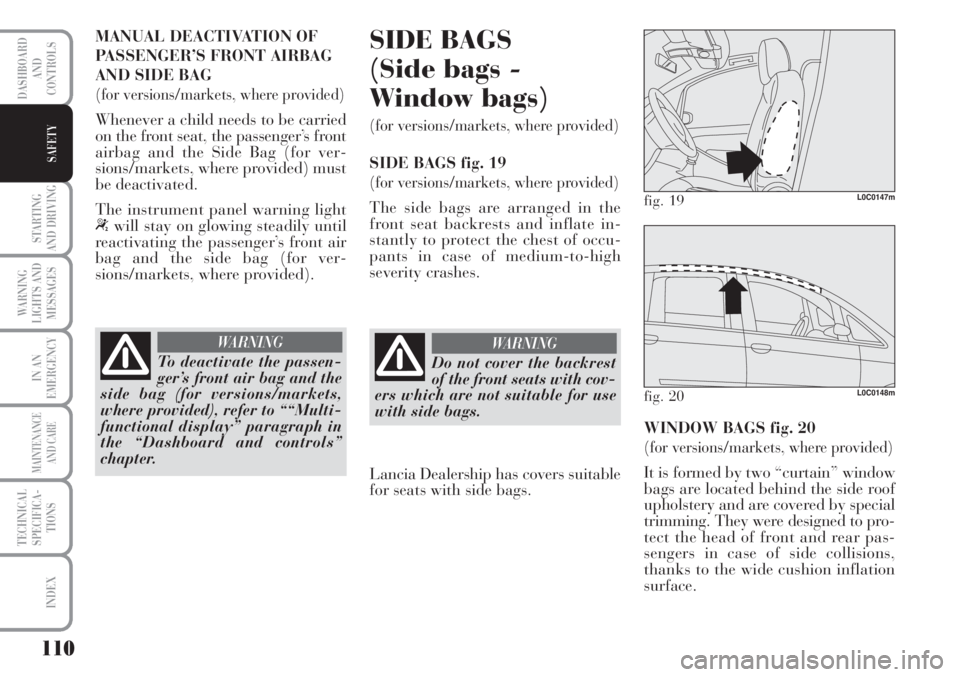
110
STARTING
AND DRIVING
WARNING
LIGHTS AND
MESSAGES
IN AN
EMERGENCY
MAINTENANCE
AND CARE
TECHNICAL
SPECIFICA-
TIONS
INDEX
DASHBOARD
AND
CONTROLS
SAFETY
MANUAL DEACTIVATION OF
PASSENGER’S FRONT AIRBAG
AND SIDE BAG
(for versions/markets, where provided)
Whenever a child needs to be carried
on the front seat, the passenger’s front
airbag and the Side Bag (for ver-
sions/markets, where provided) must
be deactivated.
The instrument panel warning light
“will stay on glowing steadily until
reactivating the passenger’s front air
bag and the side bag (for ver-
sions/markets, where provided).
SIDE BAGS
(Side bags -
Window bags)
(for versions/markets, where provided)
SIDE BAGS fig. 19
(for versions/markets, where provided)
The side bags are arranged in the
front seat backrests and inflate in-
stantly to protect the chest of occu-
pants in case of medium-to-high
severity crashes.
To deactivate the passen-
ger’s front air bag and the
side bag (for versions/markets,
where provided), refer to ““Multi-
functional display” paragraph in
the “Dashboard and controls”
chapter.
WARNING
Do not cover the backrest
of the front seats with cov-
ers which are not suitable for use
with side bags.
WARNING
fig. 19L0C0147m
fig. 20L0C0148m
WINDOW BAGS fig. 20
(for versions/markets, where provided)
It is formed by two “curtain” window
bags are located behind the side roof
upholstery and are covered by special
trimming. They were designed to pro-
tect the head of front and rear pas-
sengers in case of side collisions,
thanks to the wide cushion inflation
surface. Lancia Dealership has covers suitable
for seats with side bags.
Page 112 of 218
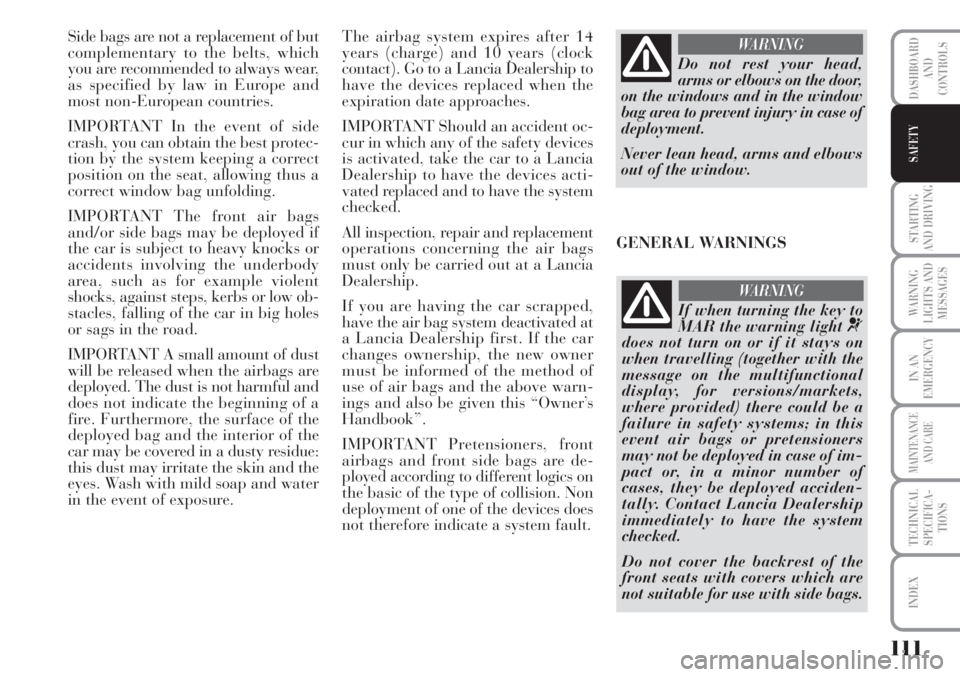
111
STARTING
AND DRIVING
WARNING
LIGHTS AND
MESSAGES
IN AN
EMERGENCY
MAINTENANCE
AND CARE
TECHNICAL
SPECIFICA-
TIONS
INDEX
DASHBOARD
AND
CONTROLS
SAFETY
Side bags are not a replacement of but
complementary to the belts, which
you are recommended to always wear,
as specified by law in Europe and
most non-European countries.
IMPORTANT In the event of side
crash, you can obtain the best protec-
tion by the system keeping a correct
position on the seat, allowing thus a
correct window bag unfolding.
IMPORTANT The front air bags
and/or side bags may be deployed if
the car is subject to heavy knocks or
accidents involving the underbody
area, such as for example violent
shocks, against steps, kerbs or low ob-
stacles, falling of the car in big holes
or sags in the road.
IMPORTANT A small amount of dust
will be released when the airbags are
deployed. The dust is not harmful and
does not indicate the beginning of a
fire. Furthermore, the surface of the
deployed bag and the interior of the
car may be covered in a dusty residue:
this dust may irritate the skin and the
eyes. Wash with mild soap and water
in the event of exposure.The airbag system expires after 14
years (charge) and 10 years (clock
contact). Go to a Lancia Dealership to
have the devices replaced when the
expiration date approaches.
IMPORTANT Should an accident oc-
cur in which any of the safety devices
is activated, take the car to a Lancia
Dealership to have the devices acti-
vated replaced and to have the system
checked.
All inspection, repair and replacement
operations concerning the air bags
must only be carried out at a Lancia
Dealership.
If you are having the car scrapped,
have the air bag system deactivated at
a Lancia Dealership first. If the car
changes ownership, the new owner
must be informed of the method of
use of air bags and the above warn-
ings and also be given this “Owner’s
Handbook”.
IMPORTANT Pretensioners, front
airbags and front side bags are de-
ployed according to different logics on
the basic of the type of collision. Non
deployment of one of the devices does
not therefore indicate a system fault.
Do not rest your head,
arms or elbows on the door,
on the windows and in the window
bag area to prevent injury in case of
deployment.
Never lean head, arms and elbows
out of the window.
WARNING
If when turning the key to
MAR the warning light ¬does not turn on or if it stays on
when travelling (together with the
message on the multifunctional
display, for versions/markets,
where provided) there could be a
failure in safety systems; in this
event air bags or pretensioners
may not be deployed in case of im-
pact or, in a minor number of
cases, they be deployed acciden-
tally. Contact Lancia Dealership
immediately to have the system
checked.
Do not cover the backrest of the
front seats with covers which are
not suitable for use with side bags.
WARNING
GENERAL WARNINGS
Page 113 of 218
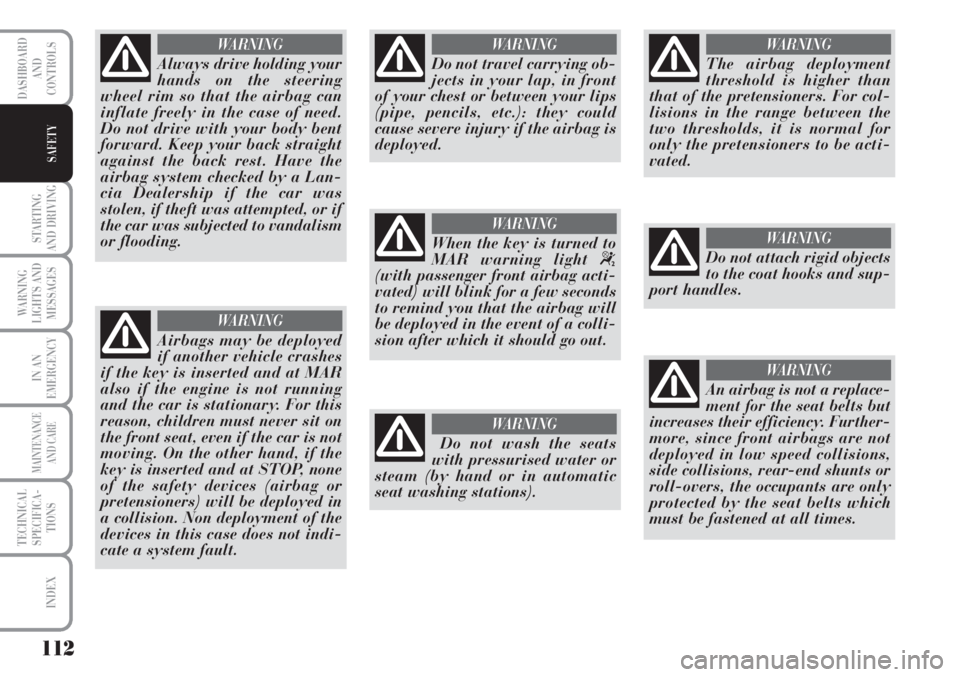
112
STARTING
AND DRIVING
WARNING
LIGHTS AND
MESSAGES
IN AN
EMERGENCY
MAINTENANCE
AND CARE
TECHNICAL
SPECIFICA-
TIONS
INDEX
DASHBOARD
AND
CONTROLS
SAFETY
Always drive holding your
hands on the steering
wheel rim so that the airbag can
inflate freely in the case of need.
Do not drive with your body bent
forward. Keep your back straight
against the back rest. Have the
airbag system checked by a Lan-
cia Dealership if the car was
stolen, if theft was attempted, or if
the car was subjected to vandalism
or flooding.
WARNING
Do not travel carrying ob-
jects in your lap, in front
of your chest or between your lips
(pipe, pencils, etc.): they could
cause severe injury if the airbag is
deployed.
WARNING
The airbag deployment
threshold is higher than
that of the pretensioners. For col-
lisions in the range between the
two thresholds, it is normal for
only the pretensioners to be acti-
vated.
WARNING
When the key is turned to
MAR warning light
“(with passenger front airbag acti-
vated) will blink for a few seconds
to remind you that the airbag will
be deployed in the event of a colli-
sion after which it should go out.
WARNING
Do not wash the seats
with pressurised water or
steam (by hand or in automatic
seat washing stations).
WARNING
An airbag is not a replace-
ment for the seat belts but
increases their efficiency. Further-
more, since front airbags are not
deployed in low speed collisions,
side collisions, rear-end shunts or
roll-overs, the occupants are only
protected by the seat belts which
must be fastened at all times.
WARNING
Do not attach rigid objects
to the coat hooks and sup-
port handles.
WARNING
Airbags may be deployed
if another vehicle crashes
if the key is inserted and at MAR
also if the engine is not running
and the car is stationary. For this
reason, children must never sit on
the front seat, even if the car is not
moving. On the other hand, if the
key is inserted and at STOP, none
of the safety devices (airbag or
pretensioners) will be deployed in
a collision. Non deployment of the
devices in this case does not indi-
cate a system fault.
WARNING
Page 114 of 218
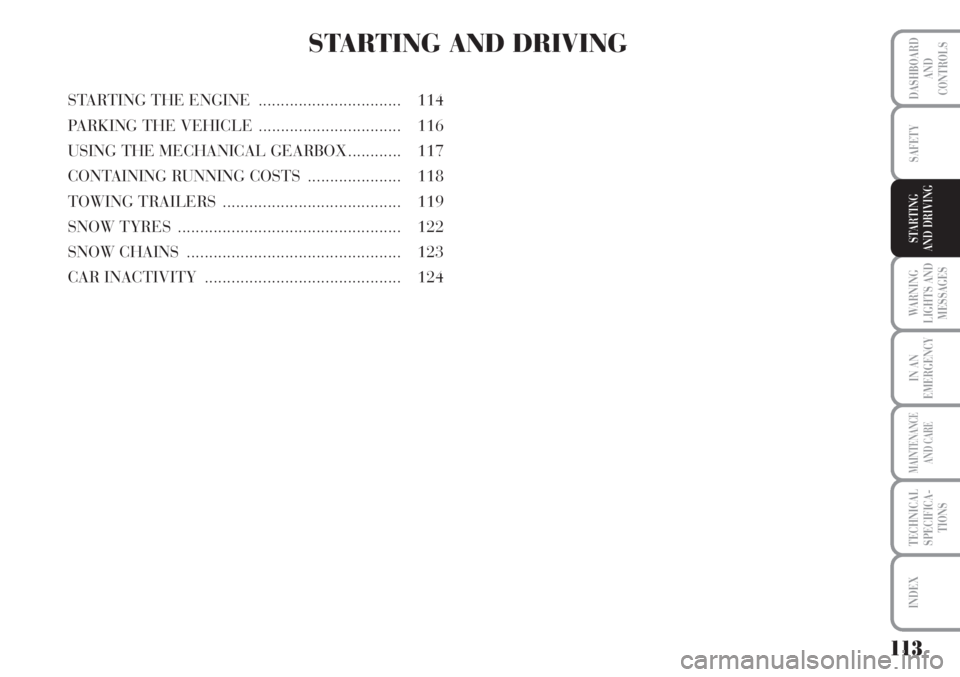
113
WARNING
LIGHTS AND
MESSAGES
IN AN
EMERGENCY
MAINTENANCE
AND CARE
TECHNICAL
SPECIFICA-
TIONS
INDEX
DASHBOARD
AND
CONTROLS
SAFETY
STARTING
AND DRIVING
STARTING AND DRIVING
STARTING THE ENGINE................................ 114
PARKING THE VEHICLE ................................ 116
USING THE MECHANICAL GEARBOX............ 117
CONTAINING RUNNING COSTS ..................... 118
TOWING TRAILERS ........................................ 119
SNOW TYRES .................................................. 122
SNOW CHAINS ................................................ 123
CAR INACTIVITY ............................................ 124
Page 115 of 218
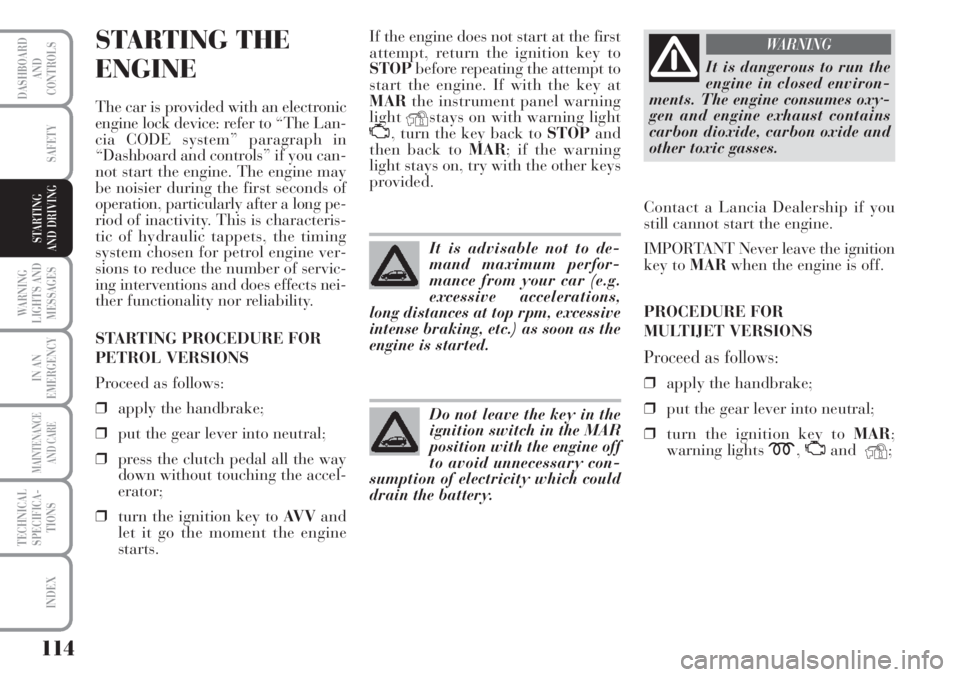
114
WARNING
LIGHTS AND
MESSAGES
IN AN
EMERGENCY
MAINTENANCE
AND CARE
TECHNICAL
SPECIFICA-
TIONS
INDEX
DASHBOARD
AND
CONTROLS
SAFETY
STARTING
AND DRIVING
STARTING THE
ENGINE
The car is provided with an electronic
engine lock device: refer to “The Lan-
cia CODE system” paragraph in
“Dashboard and controls” if you can-
not start the engine. The engine may
be noisier during the first seconds of
operation, particularly after a long pe-
riod of inactivity. This is characteris-
tic of hydraulic tappets, the timing
system chosen for petrol engine ver-
sions to reduce the number of servic-
ing interventions and does effects nei-
ther functionality nor reliability.
STARTING PROCEDURE FOR
PETROL VERSIONS
Proceed as follows:
❒apply the handbrake;
❒put the gear lever into neutral;
❒press the clutch pedal all the way
down without touching the accel-
erator;
❒turn the ignition key to AV Vand
let it go the moment the engine
starts.If the engine does not start at the first
attempt, return the ignition key to
STOPbefore repeating the attempt to
start the engine. If with the key at
MARthe instrument panel warning
lightYstays on with warning lightU, turn the key back to STOPand
then back to MAR; if the warning
light stays on, try with the other keys
provided.
It is dangerous to run the
engine in closed environ-
ments. The engine consumes oxy-
gen and engine exhaust contains
carbon dioxide, carbon oxide and
other toxic gasses.
WARNING
It is advisable not to de-
mand maximum perfor-
mance from your car (e.g.
excessive accelerations,
long distances at top rpm, excessive
intense braking, etc.) as soon as the
engine is started.
Do not leave the key in the
ignition switch in the MAR
position with the engine off
to avoid unnecessary con-
sumption of electricity which could
drain the battery.
Contact a Lancia Dealership if you
still cannot start the engine.
IMPORTANT Never leave the ignition
key to MARwhen the engine is off.
PROCEDURE FOR
MULTIJET VERSIONS
Proceed as follows:
❒apply the handbrake;
❒put the gear lever into neutral;
❒turn the ignition key to MAR;
warning lights m,
UandY;
Page 116 of 218
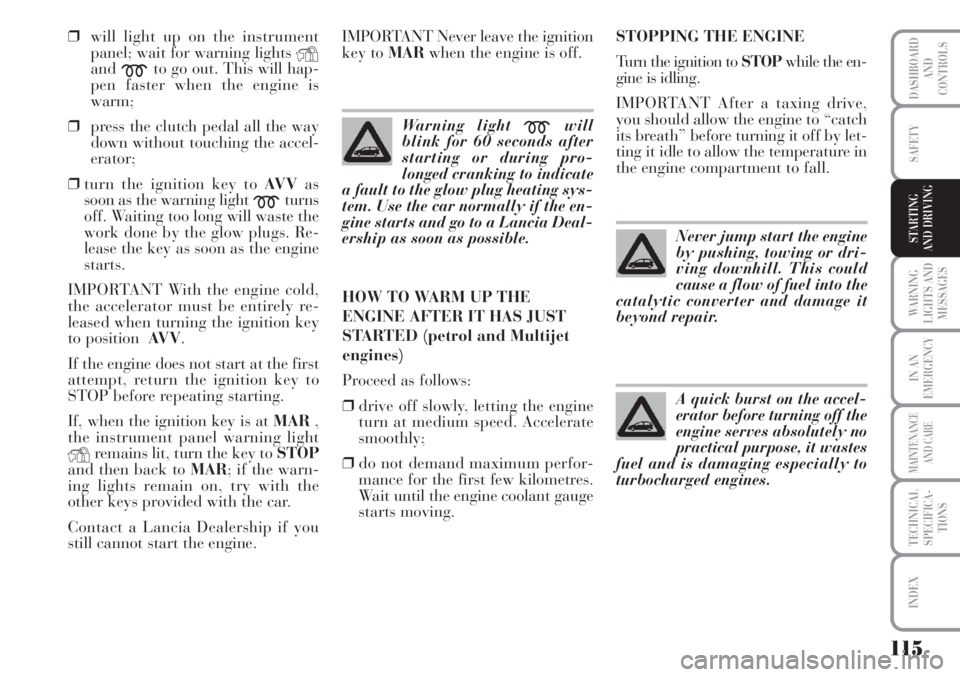
115
WARNING
LIGHTS AND
MESSAGES
IN AN
EMERGENCY
MAINTENANCE
AND CARE
TECHNICAL
SPECIFICA-
TIONS
INDEX
DASHBOARD
AND
CONTROLS
SAFETY
STARTING
AND DRIVING
❒will light up on the instrument
panel; wait for warning lights
Yand
mto go out. This will hap-
pen faster when the engine is
warm;
❒press the clutch pedal all the way
down without touching the accel-
erator;
❒turn the ignition key to AV Vas
soon as the warning light
mturns
off. Waiting too long will waste the
work done by the glow plugs. Re-
lease the key as soon as the engine
starts.
IMPORTANT With the engine cold,
the accelerator must be entirely re-
leased when turning the ignition key
to position AV V.
If the engine does not start at the first
attempt, return the ignition key to
STOP before repeating starting.
If, when the ignition key is at MAR,
the instrument panel warning light
Yremains lit, turn the key to STOP
and then back to MAR; if the warn-
ing lights remain on, try with the
other keys provided with the car.
Contact a Lancia Dealership if you
still cannot start the engine.HOW TO WARM UP THE
ENGINE AFTER IT HAS JUST
STARTED (petrol and Multijet
engines)
Proceed as follows:
❒drive off slowly, letting the engine
turn at medium speed. Accelerate
smoothly;
❒do not demand maximum perfor-
mance for the first few kilometres.
Wait until the engine coolant gauge
starts moving.Warning light
mwill
blink for 60 seconds after
starting or during pro-
longed cranking to indicate
a fault to the glow plug heating sys-
tem. Use the car normally if the en-
gine starts and go to a Lancia Deal-
ership as soon as possible.
STOPPING THE ENGINE
Turn the ignition to STOPwhile the en-
gine is idling.
IMPORTANT After a taxing drive,
you should allow the engine to “catch
its breath” before turning it off by let-
ting it idle to allow the temperature in
the engine compartment to fall.
Never jump start the engine
by pushing, towing or dri-
ving downhill. This could
cause a flow of fuel into the
catalytic converter and damage it
beyond repair.
A quick burst on the accel-
erator before turning off the
engine serves absolutely no
practical purpose, it wastes
fuel and is damaging especially to
turbocharged engines.
IMPORTANT Never leave the ignition
key to MARwhen the engine is off.
Page 117 of 218
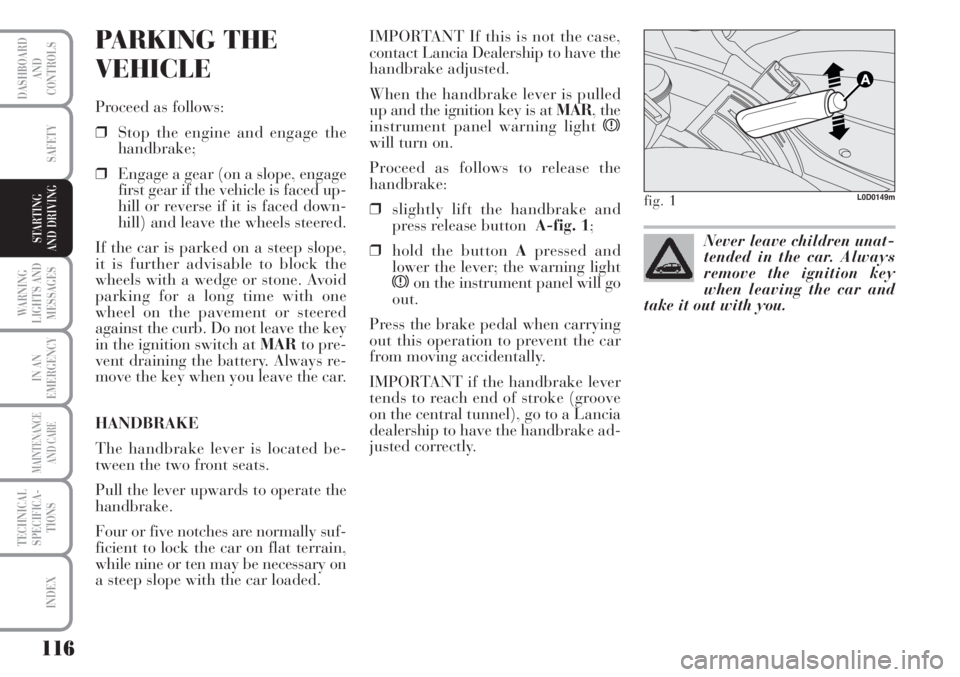
116
WARNING
LIGHTS AND
MESSAGES
IN AN
EMERGENCY
MAINTENANCE
AND CARE
TECHNICAL
SPECIFICA-
TIONS
INDEX
DASHBOARD
AND
CONTROLS
SAFETY
STARTING
AND DRIVING
PARKING THE
VEHICLE
Proceed as follows:
❒Stop the engine and engage the
handbrake;
❒Engage a gear (on a slope, engage
first gear if the vehicle is faced up-
hill or reverse if it is faced down-
hill) and leave the wheels steered.
If the car is parked on a steep slope,
it is further advisable to block the
wheels with a wedge or stone. Avoid
parking for a long time with one
wheel on the pavement or steered
against the curb. Do not leave the key
in the ignition switch at MARto pre-
vent draining the battery. Always re-
move the key when you leave the car.
HANDBRAKE
The handbrake lever is located be-
tween the two front seats.
Pull the lever upwards to operate the
handbrake.
Four or five notches are normally suf-
ficient to lock the car on flat terrain,
while nine or ten may be necessary on
a steep slope with the car loaded. IMPORTANT If this is not the case,
contact Lancia Dealership to have the
handbrake adjusted.
When the handbrake lever is pulled
up and the ignition key is at MAR, the
instrument panel warning light
xwill turn on.
Proceed as follows to release the
handbrake:
❒slightly lift the handbrake and
press release button A-fig. 1;
❒hold the button Apressed and
lower the lever; the warning light
xon the instrument panel will go
out.
Press the brake pedal when carrying
out this operation to prevent the car
from moving accidentally.
IMPORTANT if the handbrake lever
tends to reach end of stroke (groove
on the central tunnel), go to a Lancia
dealership to have the handbrake ad-
justed correctly.
fig. 1L0D0149m
Never leave children unat-
tended in the car. Always
remove the ignition key
when leaving the car and
take it out with you.